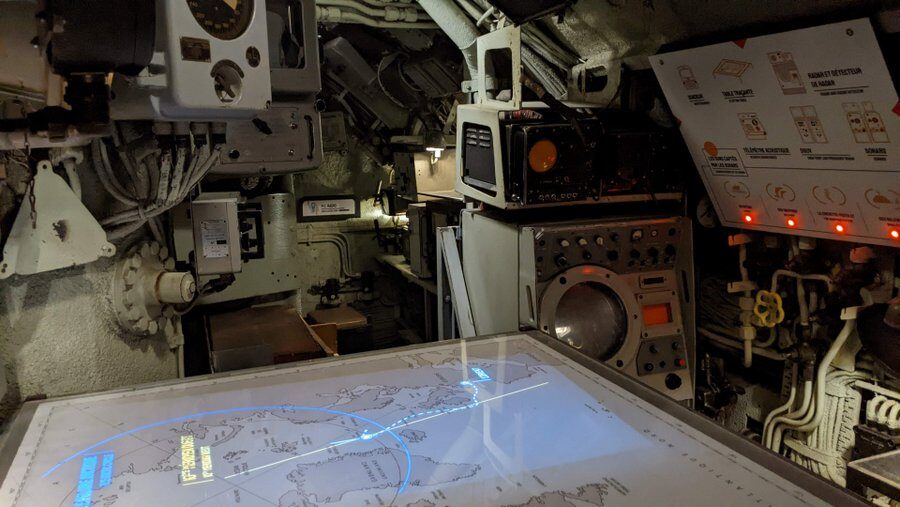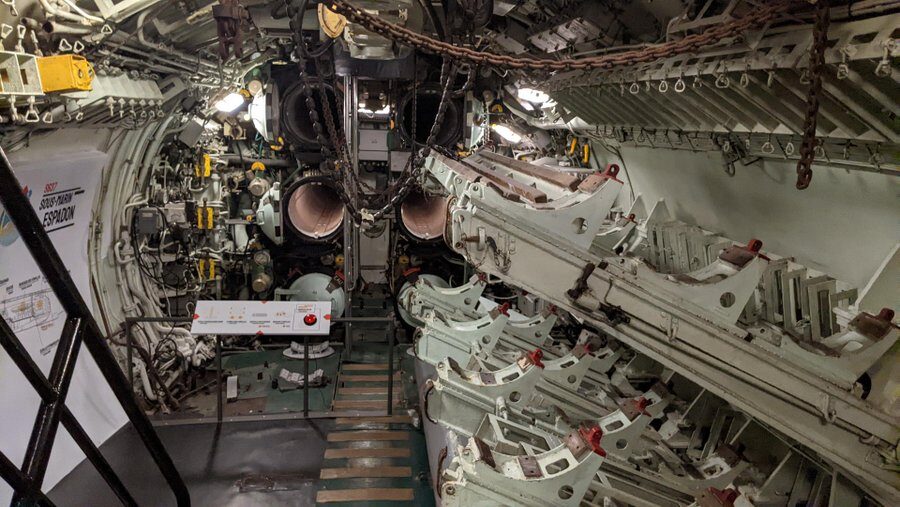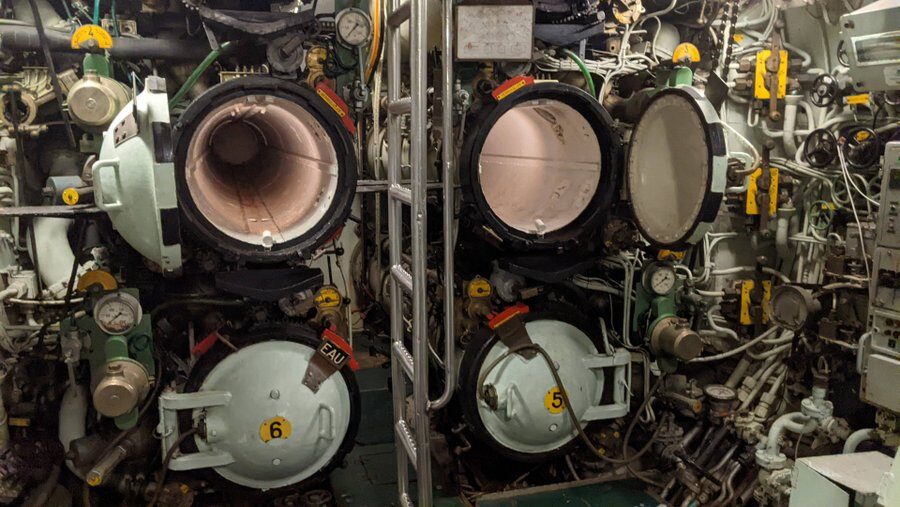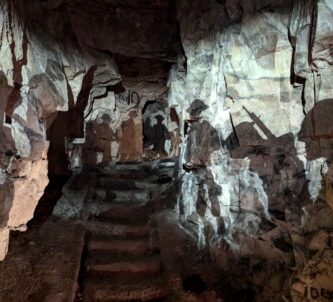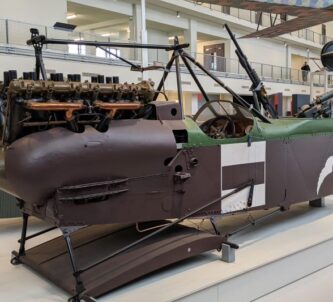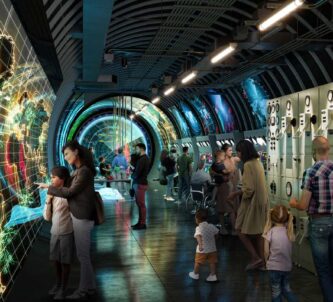Espadon (“Swordfish”) is a French submarine from the Cold War era, now a museum ship on display in Saint-Nazaire.
Other Saint-Nazaire Posts
History of submarine Espadon
She was built at the Augustin Normand shipyards in Le Havre in 1958 and commissioned into the French Navy in 1960. She was the fifth of six Narval class submarines, the first generation of new high-performance French submarines built after the Second World War.
Her early years were troublesome. She suffered a number of accidents. In 1961 she was a target for mock torpedo exercises; successful excercises as it turned out because two practise torpedoes (inert) managed to disable her by hitting her propeller.
Then, a few months after her propeller was repaired she collided underwater with another submarine causing extensive damage to her bow and her sail.
But her claim to fame was an arctic patrol under the pack ice in the Norwegian Sea with her sister ship Marsouin in May 1964.
The Narval class subs had an excellent performance for their day. They could remain submerged at depths down to 200m , for between 5 – 6 days before needing to recharge. On the surface they could travel at 16 knots (30 km/h; 18 mph), and even faster underwater: 18 knots (33 km/h; 21 mph). Their long range (15,000 nautical miles at 8 knots), combined with their highly sophisticated detection equipment ** and relatively silent propulsion system made them perfect for their role as deep sea patrol vessels.
After a two year refit between 1966 to 1968, Espadon spent the remaining 17 years of her career patrolling from the West Indies to the Mediterranean, and from the Arctic to sub-Sahara Africa. In total, she completed 2,561 days at sea (33,796 hours underwater) and sailed 360,547 miles, the equivalent of 17 times around the Earth.

Espadon was decommissioned in 1985 and on 10th September that year she departed her base at Lorient and towed to Saint Nazaire to become the first French submarine to be opened to the public.
Espadon, the museum
When Espadon was put on display in the fortified lock at Saint Nazaire, they had to make her accessible for visitors. Like many/most museum submarines, that meant cutting access doors at each end of the hull. Usually that’s easy; you just cut holes in the side (eg. HMS Alliance Gosport, U-505 Chicago, U-995 Kiel) but Espadon is ‘wet-berthed’. She’s the only one of four French submarine museums that is floating. That has its disadvantages.
It means the doors have to be cut in the top, so visitors have to negotiate steep stairs to get in at the stern and out at the bow. It also means the submarine is more prone to corrosion & rust. (See USS Clamagore at Patriots Point USA… well, you can’t anymore. She was so damaged she had to be scrapped this year).
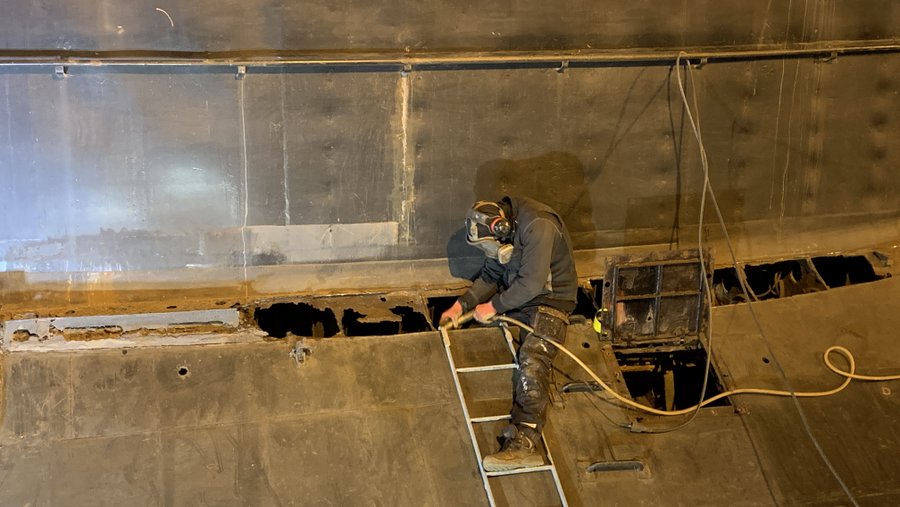
Last year the city of Saint Nazaire, with help from other organisations, began a six month/450,000 Euro (396k GBP, 439k USD) restoration project on the sixty-year old submarine, to repair the corrosion and other deterioration. She reopened to visitors in July 21.
Espadon, the visit
The museum provides proximity-triggered audio guide headphones in multiple languages and there were two options for the English audio guides when I went. For kids and adults wanting basic information about submarines, the way they work, the compartments, etc, there is an audio narration by an actor playing the youngest sailor in the crew.
I went for the other option, which was a narration by an actor playing the role of a journalist who was on board for the historic voyage to the Arctic. It was good but it didn’t really address some of the key questions I had about the design of the submarine.
The first one, and despite lengthy post-visit research and queries on naval forums I still don’t have an answer to this one (if you do PLEASE comment below!), is the totally weird bow dive planes!
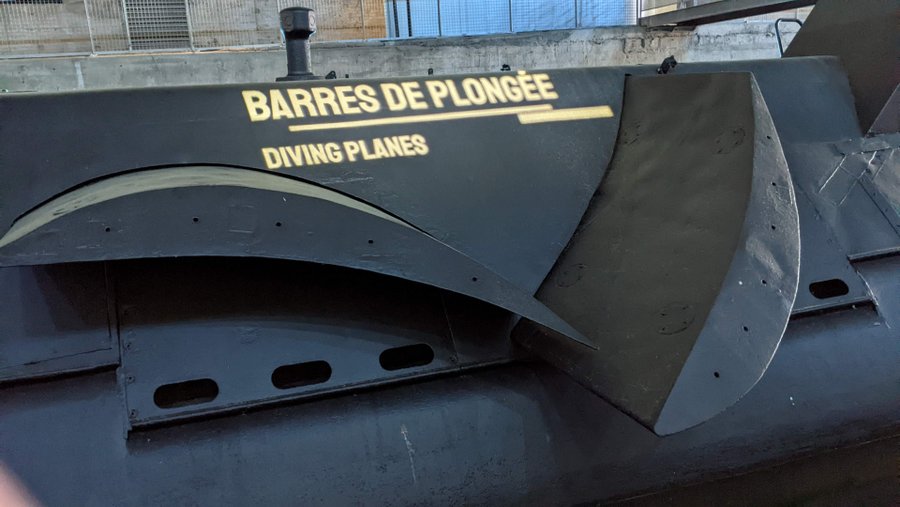
Wait! Who? er …what?… why were they designed like that? …how did they operate? Were they any good? I’ve never seen anything like them, and they are completely out of the blue. The last generation of U-boat, the XXI class, were the inspiration for France’s Narval class. The French were given one at the end of the war as war reparations. The Roland Morillot, formerly U-2518, became the model for the new Narval class… but it had normal pivoting hydroplanes at the bow. So where did this pair of extending fixed blades come from?
I can see how, recessed, they would be suitable for surfacing in ice, but most traditional planes can be folded back, up, or recessed, so there’s no advantage there. I can see how by controlling the amount they are extended you could control their effect, but the angles of pitch just look odd, especially the aft down-blade which looks very severe.
A nice touch is the way signage (like the dive planes) & diagrams of key parts of the submarine, like periscopes & snorkel, are projected onto the hull.
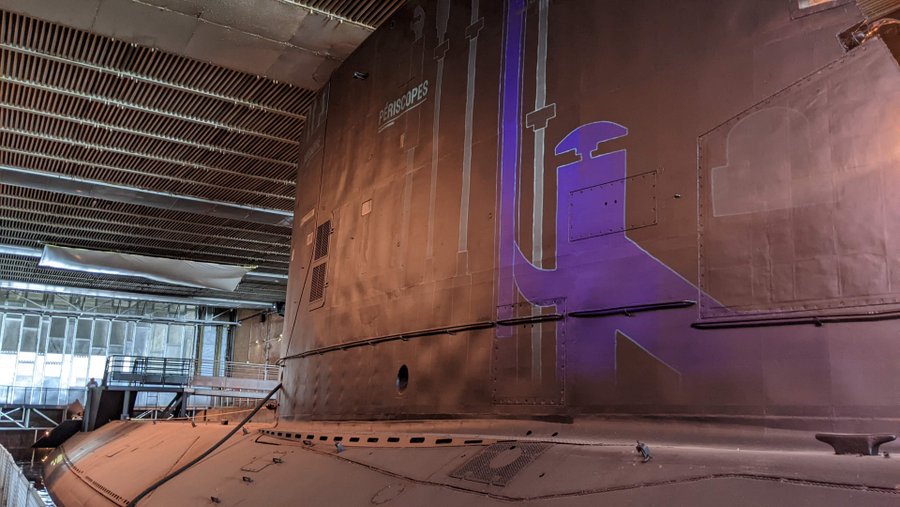
So, down into the hull.
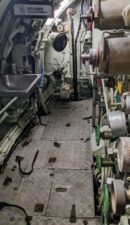
not a torpedo room,
a Special Forces facility!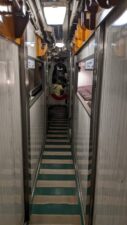
Access is down a steep set of steps at the stern and I was expecting to arrive in the aft torpedo room. That’s the standard layout for submarines from this era. It turns out Narval class subs, including Espadon did originally have 2 x stern tubes but they were removed during her refit in 1966 to make way for Special Forces gear and exit chambers for combat swimmers.
The next thing that surprised me the seeming absence of engines and motors. Normally you expect the diesel engines and electric motors to be accessible, so engineers can walk around them and work on them. The engines and motors on Espadon are tucked away below the main deck, with only the tops exposed. I’m sure a small engineer could get down there to work on them, but not easily.
Normally in post-WW2 submarines, the batteries run the whole length of the keel under the main deck which has the engine compartment, motor room, control room, crew quarters and torpedo rooms. The batteries on Espadon are located under the main deck but forward of the sail. That double deck space aft of the sail is taken up by the engines & motors.
In that respect Espadon is like her design mother, the type XXI U-boat, but the XXI was a two-deck submarine. The batteries were in the front half of the XXI on the keel deck and 1st deck, with crew areas etc on the second deck. However the XXI is a single-decker when you get to the torpedo & engine compartments where space is needed. So why didn’t the Narval class do the same?
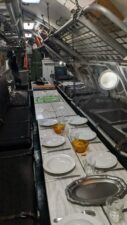
That was the other thing that really struck me on Espadon. All submarines are cramped, but most that I’ve encountered feel luxuriously spacious compared to Espadon. There is a mass of machinery and equipment crammed into every nook & cranny, so how the crew managed to simply get about – pass each other in the corridor, puzzled me.
Just like every pre-nuclear submarine there’s one tiny galley, one seawater shower & one toilet to serve a large crew of 63 crew, who are of course, ‘hot-bunking’ – the off-watch crew clamber sleepily into the tiny bunks vacated by the crew going on-watch. Presumably there needed to be so many crew to operate this mass of machinery and the Espadon‘s complex warfare systems.

Here’s something else that was a mystery to me. This is a typical dive control panel (bathed in a red night light) with the two seats for the bow & stern planesmen.
…but if the bow planes are these weird fixed-pitch blades, why does the planesman controls for them (left) match the traditional pitch blade controls for the aft planes?
As you work through the submarine from stern to bow, the final section is the forward torpedo compartment*** , which is where you have to remind yourself, there was a fatal fire on 13 Aug 1963. Three crew suffered from the inhalation of smoke and toxic fumes, and a fourth died. It would have been a lot more densely packed back then with a full set of torpedoes.
Now, half the compartment has been emptied to make way for the exit stairs, and I notice there’s a barrier to keep visitors away from the torpedo tubes. After all, you wouldn’t want somebody to open one… Espadon is wet-berthed remember!
The Espadon – more questions asked than answered! But if you are interested in submarines then she’s definitely worth a visit.
* Crush depth was 400m
** Passive listening sonar DSUV2 (allows the operator to locate a noise and its bearing)
Sonars with chart recorders
Nautilus acoustic rangefinder (calculates the exact distance separating the submarine from the noisemaker, using three microphones on the bow, stern and centre of the submarine)
Two sound emission interceptors (one direction interceptor and one frequency interceptor)
*** Espadon used to have an aft torpedo compartment with 2 x tubes, but it was removed in the refit of 1966 so they could pack more gear in there.
Declaration: I was on a self-driving press trip and visited Saint Nazaire as a guest of Saint Nazaire Tourisme. Museum entry was complementary.
Factbox
Website:
Submarine Espadon
Location:
This can be confusing. Espadon is generally referred to as being located at the submarine base in Saint Nazaire, and from photographs it looks as if she is in one of the pens in the former U-Boat base. In fact she is in the fortified lock on the opposite side of the basin. The Germans quite rightly realised that it was pointless building an 8-metre thick concrete bunker for their U-boats if the Allies were to bomb the locks into the basin and cut it off from the sea, so they built a similar fortification over one of the locks. Espadon shares the building with the EOL – Aeolian Centre.
Entry Price (2023):
| Adult | Reduced* | Child (4-17) | |
|---|---|---|---|
| Espadon submarine | € 12.00 | € 10.00 | € 6.00 |
| Fortified Lock Combo (EOL Centre éolien + Submarine Espadon) | € 16.00 | € 8.00 | |
| Combined Ticket (Espadon submarine + Escal’Atlantic + Écomusée + EOL Centre éolien) | € 28.00 | € 14.00 |
* Reduced tickets are for students, job seekers, people with disabilities with one accompanying person
Children under the age of 4 and Annual PASS holders have free entry. Admission is also free on the first Sunday of the month, except July and August.
Opening Days:
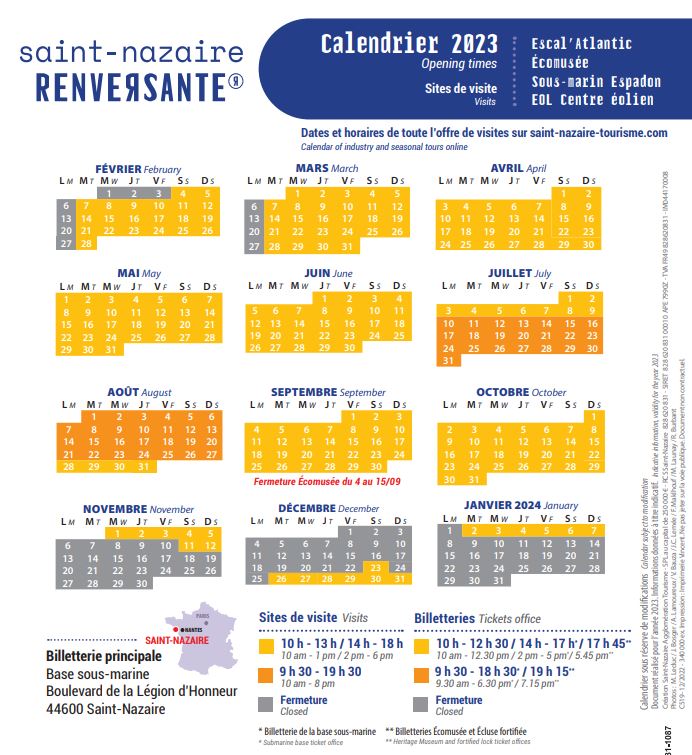 The four Saint-Nazaire Tourisme attractions (EOL Centre éolien, Submarine Espadon, Écomusée & Escal’Atlantic) share the same calendar. They are open on most days during the summer but as you get into the winter the dates become more specific and you need to check if the actual date you want to visit is available on the website.
The four Saint-Nazaire Tourisme attractions (EOL Centre éolien, Submarine Espadon, Écomusée & Escal’Atlantic) share the same calendar. They are open on most days during the summer but as you get into the winter the dates become more specific and you need to check if the actual date you want to visit is available on the website.



